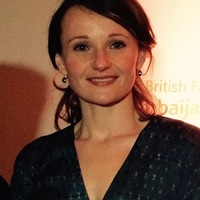Kasia Ploskonka
SOAS University of London, History of Art & Archaeology, Department Member
- My main interests are to research, develop and deliver platforms for the international presentation of fine arts and research from lesser-represented areas to a wider audience with particular interest in Central Asia. The Central Asian republics, independent as of 1991, have and continue to undergo cultural, political and economic transformations as post-... moreMy main interests are to research, develop and deliver platforms for the international presentation of fine arts and research from lesser-represented areas to a wider audience with particular interest in Central Asia. The Central Asian republics, independent as of 1991, have and continue to undergo cultural, political and economic transformations as post-colonial states. For my PhD my broad interests lie in the conjunction between art and politics, more specifically in how contemporary artistic practices challenge post-Soviet political and societal conventions. I will focus on the relationship between power, language, and place for my research. Spurred on by a single exhibition and the realization of how little is known of the visual contemporary culture of the region that lies between Russia and the Middle East.edit
Performing in the Interstice of Mutating Regimes: Erbossyn Meldibekov and the Rhetoric of Representation focuses on the deconstruction of the post-colonial formation of self-conscious. The transition of Kazakhstan from under the rule of... more
Performing in the Interstice of Mutating Regimes: Erbossyn Meldibekov and the Rhetoric of Representation focuses on the deconstruction of the post-colonial formation of self-conscious. The transition of Kazakhstan from under the rule of the Soviet Union to an independent society in 1991 left the people divided due to an unfettered capitalist induced chaos. The desire for Kazakhstan’s government to establish itself globally and the external demand for natural resources, fossil fuels and minerals, created unregulated privatization and adoption of yet another set foreign values – capitalism. The changing regimes have significantly impacted how the people of Kazakhstan view themselves and the external discourse surrounding the Central Asian body. Meldibekov’s oeuvre attempts to deconstruct Kazakh identity, post-colonial rhetoric and re-contextualise the neo- colonial frameworks within which he exists. The conclusion points to the shift from the masterful deconstruction of self-consciousness into the more complex unconscious performative of melancholia.
Research Interests:
Research Interests:
This article examines artistic intervention into local conventions as a means of eliciting social awareness within the current cultural space of Dushanbe, Tajikistan, in which self-censorship is commonplace. As is to be expected, the art... more
This article examines artistic intervention into local conventions as a means of eliciting social awareness within the current cultural space of Dushanbe, Tajikistan, in which self-censorship is commonplace. As is to be expected, the art receiving the greatest support is sponsored by the authoritarian regime, who use it as a soft tool to construct a desired or prescribed form of national identity and to project state symbols into the global arena. In contrast, artworks which are contentious in their subject matter are mainly supported through international agencies. I explore the agency and autonomy of contemporary art, notwithstanding continuing state efforts at controlling, co-opting and incorporating art into a nationalist and legitimizing narrative. By focusing on selected artworks shown in Dushanbe within the last decade, where there are only a handful of artists work in this genre, I investigate how they unpack current societal issues of women's rights, shifting ideologies, Islamization and civic duty.
Research Interests:
The following article will cover three contemporary notions of identity and power in Central Asia through the use of post-Soviet contemporary art studies. Case studies will consist of topical artworks on the thematics of mankurtism,... more
The following article will cover three contemporary notions of identity and power in Central Asia through the use of post-Soviet contemporary art studies. Case studies will consist of topical artworks on the thematics of mankurtism, monuments and marketing within post- Soviet Central Asia. The themes transition from what has been seen as an erasure of long- standing cultural tradition, language and lifestyle by Soviet colonisation, known as mankurtization in Chingiz Aitmatov’s literary language. After which, crucial in the creation of memory, fostering allegiance and modern credence has been the indoctrination of new identities. Based on nation-building while still under the Soviets, propagandising through monuments has been an example of this. With the fall of the Soviet Union in 1991, borders were drawn for the Central Asian Independents. Nation-building was already complete, having begun under the Soviets. What came next was a repurposing of existing tools by nation-branders left behind by the Soviets and the marketing of new identities both internally and internationally. The practice of nation-branding emerged in the mid 1990s, shortly after Central Asia’s independence. Marketing of Central Asia was aimed at building internal and international identities which have been the product of public relations campaigns, as well as government and the elites’ exercise in power. Despite the recent shared history of the region, post-independence growth has been uneven, due to the influence of geopolitics and the adoption of international models of state governance. My arguments will stem from the examination of several artist practices from different Central Asian countries coupled with their current political discourse. My aim is to show that complete identity erasure and reconstruction has not happened, but rather there has been a selective forgetting and privileging by the new elites in an attempt to solidify the importance of one’s standing on an international platform.
